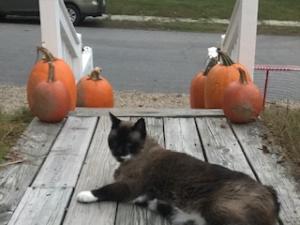Dover Veterinary Hospital Blog
Halloween Safety Tips
Halloween is just around the corner so it's time to review some safety tips. Here is a helpful list provided by the ASPCA©:

1. Lock candy safely away. Kids love to stash candy in their rooms, but a dog's keen sense of smell will lead him to even the most cleverly hidden treasure. Contact a veterinary professional right away if your pet does get into Halloween candy, especially if it contains chocolate or is sugar-free and contains xylitol.
2. Don't leave glow sticks lying around. Glow sticks are used to help keep kids safe while they are out in the dark. Pets (especially cats) find these glow sticks to be a lot of fun as well, and we commonly get calls about pets puncturing the sticks. While most of them are labeled as non-toxic, they do have an extremely bitter taste and we will often see pets who bite into them drooling and racing around the house. A little treat or sip of milk will usually stop the taste reaction.
3. Keep your pet identified and visible. There are a lot of extra people on the streets at Halloween, and that combined with strange costumes can spook pets and cause them to bolt. If you take your pet out after dark, make sure he or she wears a reflective collar and is securely leashed. And make sure your pet has proper identification on the collar.
4. Calm your pet. Even pets who are kept indoors may experience intense anxiety over the large number of strangely dressed visitors. Keeping your pet away from trick-or-treaters may do the trick, but if you think more will be needed be sure and speak with your vet well in advance about options to help calm your pet.
5. Check those costumes. Costumes can be fun for the whole family. If you are planning on dressing up your best bud, ensure that the costume fits well and isn't going to slip and tangle the pet or cause a choking hazard if chewed on. Never leave a costumed pet unattended.

1. Lock candy safely away. Kids love to stash candy in their rooms, but a dog's keen sense of smell will lead him to even the most cleverly hidden treasure. Contact a veterinary professional right away if your pet does get into Halloween candy, especially if it contains chocolate or is sugar-free and contains xylitol.
2. Don't leave glow sticks lying around. Glow sticks are used to help keep kids safe while they are out in the dark. Pets (especially cats) find these glow sticks to be a lot of fun as well, and we commonly get calls about pets puncturing the sticks. While most of them are labeled as non-toxic, they do have an extremely bitter taste and we will often see pets who bite into them drooling and racing around the house. A little treat or sip of milk will usually stop the taste reaction.
3. Keep your pet identified and visible. There are a lot of extra people on the streets at Halloween, and that combined with strange costumes can spook pets and cause them to bolt. If you take your pet out after dark, make sure he or she wears a reflective collar and is securely leashed. And make sure your pet has proper identification on the collar.
4. Calm your pet. Even pets who are kept indoors may experience intense anxiety over the large number of strangely dressed visitors. Keeping your pet away from trick-or-treaters may do the trick, but if you think more will be needed be sure and speak with your vet well in advance about options to help calm your pet.
5. Check those costumes. Costumes can be fun for the whole family. If you are planning on dressing up your best bud, ensure that the costume fits well and isn't going to slip and tangle the pet or cause a choking hazard if chewed on. Never leave a costumed pet unattended.

